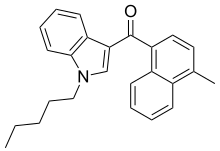 | |
| Legal status | |
|---|---|
| Legal status |
|
| Identifiers | |
| |
| CAS Number | |
| ChemSpider | |
| UNII | |
| KEGG | |
| ChEMBL | |
| CompTox Dashboard (EPA) | |
| Chemical and physical data | |
| Formula | C25H25NO |
| Molar mass | 355.481 g·mol−1 |
| 3D model (JSmol) | |
| |
| |
| | |
JWH-122 is a synthetic cannabimimetic that was discovered by John W. Huffman. It is a methylated analogue of JWH-018. It has a Ki of 0.69 nM at CB1 and 1.2 nM at CB2.[2]
In January 2015, over 40 people were reportedly sickened after eating a holiday bread called Rosca de reyes purchased at a bakery in Santa Ana, California, that was laced with JWH-122.[3]
Legal status
Australia
JWH-122 is considered a Schedule 9 prohibited substance in Australia under the Poisons Standard (October 2015).[4] A Schedule 9 substance is a substance which may be abused or misused, the manufacture, possession, sale or use of which should be prohibited by law except when required for medical or scientific research, or for analytical, teaching or training purposes with approval of Commonwealth and/or State or Territory Health Authorities.[4]
China
As of October 2015 JWH-122 is a controlled substance in China.[5]
United States
In the United States, JWH-122 is a Schedule I Controlled Substance.[6]
See also
References
- ^ Anvisa (2023-07-24). "RDC Nº 804 - Listas de Substâncias Entorpecentes, Psicotrópicas, Precursoras e Outras sob Controle Especial" [Collegiate Board Resolution No. 804 - Lists of Narcotic, Psychotropic, Precursor, and Other Substances under Special Control] (in Brazilian Portuguese). Diário Oficial da União (published 2023-07-25). Archived from the original on 2023-08-27. Retrieved 2023-08-27.
- ^ Huffman JW, Zengin G, Wu MJ, Lu J, Hynd G, Bushell K, et al. (January 2005). "Structure-activity relationships for 1-alkyl-3-(1-naphthoyl)indoles at the cannabinoid CB(1) and CB(2) receptors: steric and electronic effects of naphthoyl substituents. New highly selective CB(2) receptor agonists". Bioorganic & Medicinal Chemistry. 13 (1): 89–112. doi:10.1016/j.bmc.2004.09.050. PMID 15582455.
- ^ "Tests Show Synthetic Drug Contaminated Holiday Bread from CA Bakery". Food Safety News. 2015-02-02.
- ^ a b "Poisons Standard". Federal Register of Legislation. The Australian Government. October 2015.
- ^ "关于印发《非药用类麻醉药品和精神药品列管办法》的通知" (in Chinese). China Food and Drug Administration. 27 September 2015. Archived from the original on 1 October 2015. Retrieved 1 October 2015.
- ^ "Controlled Substances" (PDF). Diversion Control Division. U.S. Department of Justice, Drug Enforcement Division (DEA).
